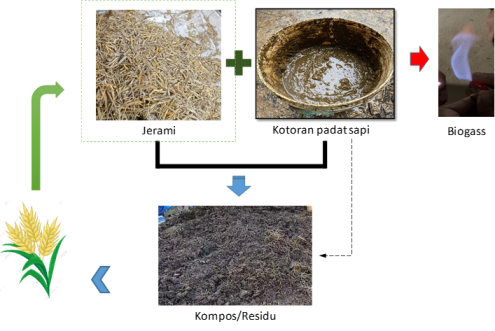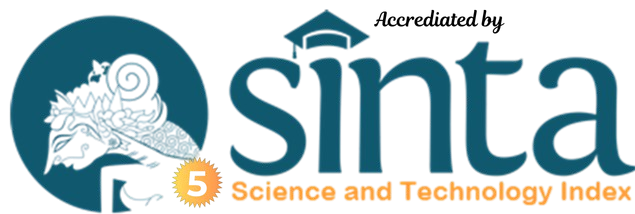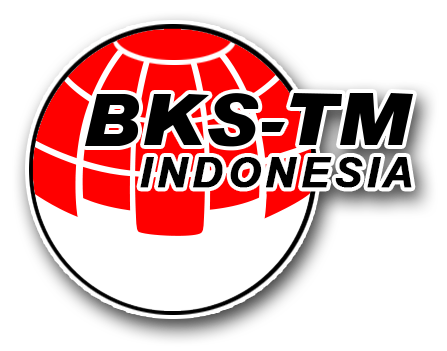Studi Karakteristik Biogas dari Kotoran Sapi dengan Penambahan Jerami
DOI:
https://doi.org/10.55679/pistonjt.v9i2.76Keywords:
Alternative energy, Cow dung, Biogas flame, Agricultural waste, StrawAbstract
Cow dung is one of the abundant energy resources, especially in rural areas, which has the potential to become an option in reducing people's dependence on fuel oil. This study aims to analyse the characteristics of biogas from cow dung as an alternative energy. The effect of paddy straw on the biogas production rate and flame characteristics was also analysed. The parameters studied were temperature, pressure, and detected gas on biogas production and flame characteristics. The results showed that biogas from cow dung produced a light blue biogas flame, with a pungent odour at a retention time period of 14 days. Flame characteristics with blue colour were observed on the 21st day of retention time, and the pungent odour (considered as a sulphur, and a carbon monoxide) was relatively reduced. Combustible gases were identified by the gas detector as EX; 100%. Other elements such as sulphur and carbon monoxide were indicated as H2S and CO by the gas detector. The intensity of these two elements decreased as the retention time increased up to 28 days. The addition of the straw of 10% of the cow dung increased the pressure rate and mass of biogas produced on day 7. The biogas combustion test on day 14 showed that the addition of straw reduced the intensity of methane gas, which was characterized by a pale blue flame due to the dominance of carbon monoxide. The effect of straw addition on biogas intensity was observed on day 21, in which the visual intensity of the flame was greater than the feedstock without the straw. In the retention time above 21 days, the straw biomass has been completely degraded, thus increasing the intensity of the burning gas flame. This study recommends carefully handling of straw biomass for additional feedstock and catalyst in the biogas production of cow solid manure such as shredding, ideal composition, and pre-treatment of non-degradable substances.
Downloads
References
M. R. Almuhtadee, A. Setiawan, A. Alchalil, and A. Aljufri, “ANALISA UNJUK KERJA GENERATOR SET BERBAHAN BAKAR BIOGAS DARI LIMBAH RUMAH MAKAN,” J. Rekayasa Mesin, vol. 14, no. 2, pp. 713–724, Aug. 2023, doi: 10.21776/jrm.v14i2.1463.
H. Yahya, “PENGARUH FERMENTASI LIMBAH RUMEN SAPI DAN RAGI TERHADAP PERFORMA KOMPOR BIOGAS,” Lingk. J. Environ. Eng., vol. 3, no. 1, pp. 57–72, Jul. 2022, doi: 10.22373/ljee.v3i1.1927.
A. P. Apriantika, R. Anwari, C. N. Janah, and I. Syaichurrozi, “Review: Biogas Production from Cow Dung and Its Potential in Indonesia,” World Chem. Eng. J., vol. 6, no. 2, p. 50, 2022, doi: 10.48181/wcej.v6i2.17994.
K. Kusmiyati, D. K. Wijaya, B. J. R. Hartono, G. F. Shidik, and A. Fudholi, “Harnessing the power of cow dung: Exploring the environmental, energy, and economic potential of biogas production in Indonesia,” Results Eng., vol. 20, no. September, p. 101431, 2023, doi: 10.1016/j.rineng.2023.101431.
A. Alengebawy, N. Ghimire, S. T. Abdelkhalek, and M. Samer, “Conversion of Bioenergy Materials to Secondary Fuels,” Encycl. Renew. Energy, Sustain. Environ., vol. 1, pp. 825–838, 2024, doi: 10.1016/b978-0-323-93940-9.00030-x.
Y. Kurniati, A. Rahmat, B. I. Malianto, D. Nandayani, and W. S. W. Pratiwi, “Review Analisa Kondisi Optimum Dalam Proses Pembuatan Biogas,” Rekayasa, vol. 14, no. 2, pp. 272–281, 2021, doi: 10.21107/rekayasa.v14i2.11305.
R. Borja, Biogas Production, Second Edi., vol. 2. Elsevier B.V., 2011. doi: 10.1016/B978-0-08-088504-9.00126-4.
N. Aryal, N. Ghimire, and S. Bajracharya, “Coupling of microbial electrosynthesis with anaerobic digestion for waste valorization,” in Advances in Bioenergy, 1st ed., vol. 5, Elsevier Inc., 2020, pp. 101–127. doi: 10.1016/bs.aibe.2020.04.003.
M. T. Nkodi et al., “Investigation of Factors Affecting Biogas Production from Cassava Peels by Fractional Factorial Design Experimental Methodology,” J. Appl. Life Sci. Int., no. May, pp. 49–56, 2020, doi: 10.9734/jalsi/2020/v23i230146.
D. A. Herawati and A. A. Wibawa, “Pengaruh Pretreatment Jerami Padi pada Produksi Biogas dari Jerami Padi dan Sampah Sayur Sawi Hijau Secara Batch,” J. Rekayasa Proses, vol. 4, no. 1, pp. 25–29, 2010.
P. Vindis, B. Mursec, M. Janzekovic, and F. Cus, “The impact of mesophilic and thermophilic anaerobic digestion on biogas production,” J. Achiev. Mater. Manucfacturing Eng., vol. 36, no. 2, 2009.
M. Mohammadianroshanfekr, M. Pazoki, M. B. Pejman, R. Ghasemzadeh, and A. Pazoki, “Kinetic modeling and optimization of biogas production from food waste and cow manure co-digestion,” Results Eng., vol. 24, no. November, p. 103477, 2024, doi: 10.1016/j.rineng.2024.103477.
N. Ilminnafik, D. Listyadi, and H. Sutjahjono, “Thermal Characteristic of Flame As Quality Parameter of Biogas of Market Waste,” Int. J. Appl. Environ. Sci., vol. 12, no. 7, pp. 1379–1385, 2017, [Online]. Available: http://www.ripublication.com

Downloads
Published
How to Cite
Issue
Section
License
Copyright (c) 2024 Piston: Jurnal Teknologi

This work is licensed under a Creative Commons Attribution-NonCommercial 4.0 International License.








